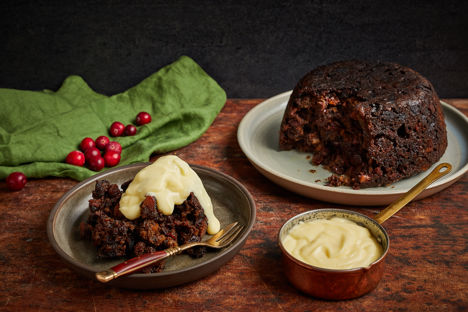
The origins of Christmas pudding
Rich, spiced and doused with brandy, the Christmas pudding is a festive staple in homes across the UK – but it has come a long way since its origins many centuries ago. We delve into the history of the beloved Yuletide dessert.
The origins of Christmas pudding
Rich, spiced and doused with brandy, the Christmas pudding is a festive staple in homes across the UK – but it has come a long way since its origins many centuries ago. We delve into the history of the beloved Yuletide dessert.
There are few foods as synonymous with the festive season as the humble Christmas pudding. Carolers demand it in We Wish You A Merry Christmas, Charles Dickens made it a centrepiece of the Cratchits’ feast in A Christmas Carol and every year in the UK we eat a massive 25 million of the sweet treats. Plenty are created from long-standing family recipes which have been handed down the generations, with the lengthy cooking process as much of a tradition as the spectacle of flaming it at the dinner table, before dolloping brandy butter on top.
When done right, it's sticky and dense, warmly spiced and distinctively dark in colour. While raisins, suet, brown sugar, spices and brandy can be found in most modern variations, the sweet, cake-like nature of today’s pudding is a far cry from its early incarnations. Spanning back as far as the 14th century and adopting several names along the way, recipes for Christmas pudding’s predecessors have evolved over the years, reflecting changes in cooking techniques, ingredients that the average home cook could get their hands on and festive traditions.
The original blueprint for Christmas pudding was frumenty, a dish which in texture was similar to porridge and was commonly eaten across medieval western Europe. In its most basic form, it was made from grains, boiled with water or milk and thickened with breadcrumbs, though more affluent families added meat such as beef or mutton, sweetened it with sugar and dried fruits and added spices such as cinnamon and saffron. It was served as a pottage, similar to a thick soup, and, rather than the post-dinner pudding we know today, is believed to have been eaten at Easter and as a fasting meal before Christmas festivities began.
In the early 15th century it became better known as plum pottage. This consisted of a mixture of meats, grains, spices and fruits (particularly raisins and currants, rather than plums) which was boiled in a bag – the fact that it didn’t require an oven made it popular among poorer families. Over time, more thickening was added, firming up its texture and inspiring its name change to plum pudding. And when sugar became cheaper and better meat preserving techniques were developed (until this point meat had often been stuffed in animals’ stomachs for preservation), creating sweet and savoury versions of dishes became easier; as the savoury side of plum pudding began to dwindle, it was replaced instead by sweeter elements.
By the mid-17th century, plum pudding's links with Christmas were so well-established that it was temporarily banned by the Puritan parliament, along with anything else deemed to be glutinous – traditional festive merriment was replaced by somewhat more sombre religious contemplation. Bah, humbug.
Thankfully, it wasn’t long before plum pudding was back on the Christmas menu and a celebrated part of the season – King George I is said (in an oft-told, but unsubstantiated, tale) to have requested it as part of his first Christmas feast in 1714, leading to his King Pudding nickname.
As the 19th century arrived, a Yuletide boiled cake of fruits, sugar and spices, often topped with a sprig of holly, had become popular, with recipes resembling the pudding we know today first appearing in the 1830s. In 1845, for example, cook Eliza Acton referred to Christmas pudding in her bestselling book Modern Cookery for Private Families. It was, after all, the Victorian era which cemented many of the festive traditions we celebrate today, including Christmas cards, decorated trees and a roasted bird for our main meal. Around this time, more families also began to embrace Stir-up Sunday, the tradition of making the pudding on the last Sunday before Advent, which takes its name from an Anglican church prayer.
It may be of British origin, but the custom of Christmas pudding has been shipped all over the world, with versions still popular in countries including Australia, New Zealand and South Africa. In the UK, it was traditionally seen as a unifying dish which rose above class, eaten by Dickens' struggling Cratchits and described as a national symbol in a 1850 newspaper article.
The addition of brandy butter came in the first decades of the 1900s, when it was also more commonplace to pour alcohol into the pudding itself, though a similar delicacy known as rum butter had been a speciality in Cumbria for some time before. And if you still hide a Christmas coin in your pudding to bring the finder good luck, that’s a tradition which is said to date back as early as the 1300s, when a dried pea or small silver ring was baked into a Twelfth Night Cake. From its early days as a porridge which was more sustenance than celebration, Christmas pudding has certainly been on quite the journey to its role as a dish at the heart of Christmas cheer.


